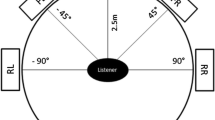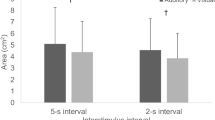Abstract
It is unclear whether the brain handles auditory cues similarly to visual cues for balance. We investigated the influence of headphones and loudspeaker reproduction of sounds on dynamic balance performance when an individual is facing a cognitive challenge. Twenty participants (16 females, aged 19–36) were asked to avoid a ball according to a specific visual rule. Visuals were projected from the HTC Vive head-mounted display in an acoustically controlled space. We varied the environment by adding congruent sounds (sounds coincide with the visual rule) or incongruent sounds (sounds may or may not coincide with the visual rule) as well as creating a multimodal (visual and congruent sounds) vs. unimodal (visual or congruent sounds only) display of stimuli. Sounds were played over headphones or loudspeakers. We quantified reaction time (RT) and accuracy (choosing the correct direction to move) by capturing the head movement. We found that in the absence of sounds, RT was slower with headphones compared to loudspeakers, but the introduction of either congruent or incongruent sounds resulted in faster movements with headphones such that RT was no longer different between apparatus. Participants used congruent sounds to improve accuracy but disregarded incongruent sounds. This suggests that selective attention may explain how sounds are incorporated into dynamic balance performance in healthy young adults. Participants leveraged sounds played over loudspeakers, but not over headphones, to enhance accuracy in a unimodal dark environment. This may be explained by the natural listening conditions created by loudspeakers where sounds may be perceived as externalized.







Similar content being viewed by others
Data availability
The complete dataset can be found at: Lubetzky, Anat (2023), “Type of Auditory cues and Apparatus influence how Healthy Young Adults Integrate Sounds for Dynamic Balance”, Mendeley Data, V1, doi: https://doi.org/10.17632/5h9pwh5zyp.1https://data.mendeley.com/datasets/5h9pwh5zyp/1.
References
Assländer L, Peterka RJ (2014) Sensory reweighting dynamics in human postural control. J Neurophysiol 111(9):1852–1864. https://doi.org/10.1152/jn.00669.2013
Blauert J (1996) Spatial hearing: the psychophysics of human sound localization. The MIT. https://doi.org/10.7551/mitpress/6391.001.0001
Bogacz R, Wagenmakers E-J, Forstmann BU, Nieuwenhuis S (2010) The neural basis of the speed–accuracy tradeoff. Trends Neurosci 33(1):10–16. https://doi.org/10.1016/j.tins.2009.09.002
Boren B, Roginska A (2011) The effects of headphones on Listener HRTF Preference. 131st Audio Eng Soc Convention 2011, 1
Deviterne D, Gauchard GC, Jamet M, Vançon G, Perrin PP (2005) Added cognitive load through rotary auditory stimulation can improve the quality of postural control in the elderly. Brain Res Bull 64(6):487–492. https://doi.org/10.1016/j.brainresbull.2004.10.007
Donohue SE, Appelbaum LG, Park CJ, Roberts KC, Woldorff MG (2013) Cross-modal stimulus conflict: the behavioral effects of stimulus input timing in a visual-auditory Stroop Task. PLoS ONE 8(4):e62802. https://doi.org/10.1371/journal.pone.0062802
Durlach NI, Rigopulos A, Pang XD, Woods WS, Kulkarni A, Colburn HS, Wenzel EM (1992) On the externalization of auditory images. Presence: Teleoperators Virtual Environ 1(2):251–257. https://doi.org/10.1162/pres.1992.1.2.251
Gandemer L, Parseihian G, Kronland-Martinet R, Bourdin C (2014) The influence of horizontally rotating sound on standing balance. Exp Brain Res 232(12):3813–3820. https://doi.org/10.1007/s00221-014-4066-y
Gandemer L, Parseihian G, Kronland-Martinet R, Bourdin C (2017) Spatial cues provided by sound improve postural stabilization: evidence of a spatial auditory map? Front NeuroSci 11:357. https://doi.org/10.3389/fnins.2017.00357
Heitz RP, Schall JD (2012) Neural mechanisms of Speed-Accuracy Tradeoff. Neuron 76(3):616–628. https://doi.org/10.1016/j.neuron.2012.08.030
Hwang S, Agada P, Kiemel T, Jeka JJ (2014) Dynamic reweighting of three modalities for Sensor Fusion. PLoS ONE 9(1):e88132. https://doi.org/10.1371/journal.pone.0088132
Jeka J, Oie KS, Kiemel T (2000) Multisensory information for human postural control: integrating touch and vision. Exp Brain Res 134(1):107–125. https://doi.org/10.1007/s002210000412
Karim AM, Rumalla K, King LA, Hullar TE (2018) The effect of spatial auditory landmarks on ambulation. Gait Posture 60:171–174. https://doi.org/10.1016/j.gaitpost.2017.12.003
Kennedy RS, Fowlkes JE, Berbaum KS, Lilienthal MG (1992) Use of a motion sickness history questionnaire for prediction of simulator sickness. Aviat Space Environ Med 63(7):588–593
Littman R, Keha E, Kalanthroff E (2019) Task Conflict and Task Control: a Mini-review. Front Psychol 10:1598. https://doi.org/10.3389/fpsyg.2019.01598
Lubetzky AV, Gospodarek M, Arie L, Kelly J, Roginska A, Cosetti M (2020) Auditory Input Postural Control Adults 146(5):8
Melara RD, Algom D (2003) Driven by information: a tectonic theory of Stroop effects. Psychol Rev 110(3):422–471. https://doi.org/10.1037/0033-295X.110.3.422
Mendelson DN, Redfern MS, Nebes RD, Jennings JR (2010) Inhibitory processes relate differently to balance/reaction time dual tasks in young and older adults. Neuropsychol Dev Cogn B Aging Neuropsychol Cogn 17(1):1–18. https://doi.org/10.1080/13825580902914040
Middlebrooks JC, Green DM (1991) Sound localization by human listeners. Ann Rev Psychol 42:135–159. https://doi.org/10.1146/annurev.ps.42.020191.001031
Multi-Channel Audio (1st ed.). Routledge. https://doi.org/10.4324/9781315707525
Roginska A, Geluso P (2017) Immersive Sound: The Art and Science of Binaural and
Ross JM, Balasubramaniam R (2015) Auditory white noise reduces postural fluctuations even in the absence of vision. Exp Brain Res 233(8):2357–2363. https://doi.org/10.1007/s00221-015-4304-y
Schall JD, Palmeri TJ, Logan GD (2017) Models of inhibitory control. Philosophical Trans Royal Soc B: Biol Sci 372(1718):20160193. https://doi.org/10.1098/rstb.2016.0193
Stroop JR (1935) Studies of interference in serial verbal reactions. J Exp Psychol 18(6):643–662. https://doi.org/10.1037/h0054651
Teaford M, Mularczyk ZJ, Gernon A, Cannon S, Kobel M, Merfeld DM (2023) Joint contributions of Auditory, proprioceptive and visual cues on human balance. Multisensory Res 36(8):865–890. https://doi.org/10.1163/22134808-bja10113
Wu Y, Lubetzky A, Arie L, Olsen A, Lin D, Harel D, Roginska A (2023), December 12 Exploring the Impact of Auditory Cues on Dynamic Balance Performance in Virtual Reality: A Comparative Study of Headphones and Loudspeakers. IEEE AIxVR 2024, Los Angeles, CA, USA
Yuval-Greenberg S, Deouell LY (2009) The dog’s meow: asymmetrical interaction in cross-modal object recognition. Exp Brain Res 193(4):603–614. https://doi.org/10.1007/s00221-008-1664-6
Zhong X, Yost WA (2013) Relationship between Postural Stability and spatial hearing. J Am Acad Audiol 24(9):782–788. https://doi.org/10.3766/jaaa.24.9.3
Acknowledgements
Special thanks are extended to Zhu Wang, PhD, Postdoctoral fellow, Courant Institute of Mathematical Sciences, for the development of the original Simulation App. Their contributions were invaluable and greatly appreciated.
Funding
This study was funded by the NYU MARL (Music and Audio Research Lab) seed award. The sponsors had no role in the study design, collection, analysis and interpretation of data; in the writing of the manuscript; or in the decision to submit the manuscript for publication.
Author information
Authors and Affiliations
Contributions
AL: Study design and conceptualization, methodology, funding, data collection, project administration, supervision, data analysis, writing-original draft, writing- review and editing. AR: Study design and conceptualization, methodology, funding, project administration, resources, supervision, writing- review and editing. DH-Funding, data analysis, visualization, writing- review and editing. LA-data collection, writing- original draft, writing- review and editing. YW- Software and system design, data collection, writing- review and editing. AO-Software and system design, writing- review and editing. DL-Software and system design, data collection, writing- review and editing.
Corresponding author
Ethics declarations
Ethics approval and consent to participate
The study was approved by the New York University Human Ethics Institutional Review Board and was therefore performed in accordance with the ethical standards laid down in the 1964 Declaration of Helsinki. Informed consent was obtained from all individual participants included in the study.
Consent for publication
The authors affirm that human research participants provided informed consent for publication of the images in Fig. 1. Participants signed informed consent regarding publishing their photographs.
Conflict of interest
The authors declare that they have no conflict of interest.
Additional information
Communicated by Francesco Lacquaniti.
Publisher’s Note
Springer Nature remains neutral with regard to jurisdictional claims in published maps and institutional affiliations.
Rights and permissions
Springer Nature or its licensor (e.g. a society or other partner) holds exclusive rights to this article under a publishing agreement with the author(s) or other rightsholder(s); author self-archiving of the accepted manuscript version of this article is solely governed by the terms of such publishing agreement and applicable law.
About this article
Cite this article
Arie, L., Roginska, A., Wu, Y. et al. Type of auditory cues and apparatus influence how healthy young adults integrate sounds for dynamic balance. Exp Brain Res (2024). https://doi.org/10.1007/s00221-024-06819-6
Received:
Accepted:
Published:
DOI: https://doi.org/10.1007/s00221-024-06819-6




